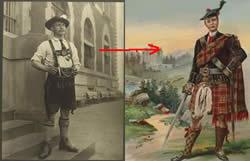January 24, 2016 - As we gather documented information about our family history, it is not uncommon to discover that our roots are not what we thought they were. This observation is reflected in a popular Ancestry.com commercial aired recently on TV. There we see a person delighted to find, through DNA evidence, that his ethnicity is primarily Scottish. “I used to envision myself dancing with my traditional German costume. Now I know that I am not German at all, so I traded in my Lederhosen for kilts.”
DNA testing for gaining genealogical information is becoming more and more common because it is difficult to doubt DNA evidence. That is the positive side; conversely, you will not gain some of the specifics you might have expected. That is because DNA results are even more complex than a genealogical chart covering many generations.
While a genealogical chart is a summary of historical facts related to specific family lineages (often questionable when based simply on secondary sources), DNA testing gives a broad, though accurate, reflection of ethnicity through genetic analysis. Here is one individual’s result that might be considered typical.
38% Ireland
23% Western Europe
17% Great Britain
13% Scandinavia
3% Iberian Peninsula
3% Eastern Europe
<1% Finland/Northwest Russia
<1% Southern Asia
1% Western Asia (Caucasus)
0% Other Regions of the World
99%-100% Total
Now, don’t take this lightly simply because the specific information you expected might be lacking; this is valuable information for those who want the broad picture of their heritage. At least, it serves as confirmation of other findings and sometimes points the researcher to new avenues for discovery.
Although easier to explain, a genealogical chart (or tree) is almost as complex. It is rather simple to recognize that the possible mix of identified ethnicities could double as past generations are added, although that is not likely to happen. For example, many of us know (or know about) our ancestors two generations back—our four grandparents. Depending on a particular situation, our grandparent’s generation could go back in time to around mid-20th century, more or less.
But, what if we went back 120 years before that, when some of our forefathers were thinking about “goin’ to Texas” or were even already first-generation Texans? Those additional years would encompass about four generations. Those of us who are not heavily involved in genealogy probably don’t know (or care) much about these gggggrandparents; maybe we should, however, since such information tells us a lot about who we are. Knowing this will confirm the complexity of our heritage; after all, there were sixty-four of them, all with exciting stories that could have been told.
If each past generation doubles the number of our ancestors in that new generation, then by going back in time to our forefathers who came to America—maybe early 18th century—we could number almost 2000 ancestors. These would be the first of their family lines to arrive in America.
Such a number of ancestors who contributed to our DNA seems mind-boggling. However, marriages in America since 1700 were often within the same ethnicity. This was especially true in rural areas (such as during the early years of Shelby County), when the choice of mates was slim, sometimes limited to neighbors or even, occasionally, to cousins.
Ethnic bonding is still common today although it is found to be progressively stronger as we regress into earlier centuries. So, while DNA results do not reflect countless ethnicities, there is good reason to find that nine ethnicities (as in the example above) is not uncommon. Indeed, most of us have a rich rather than a pure heritage.









